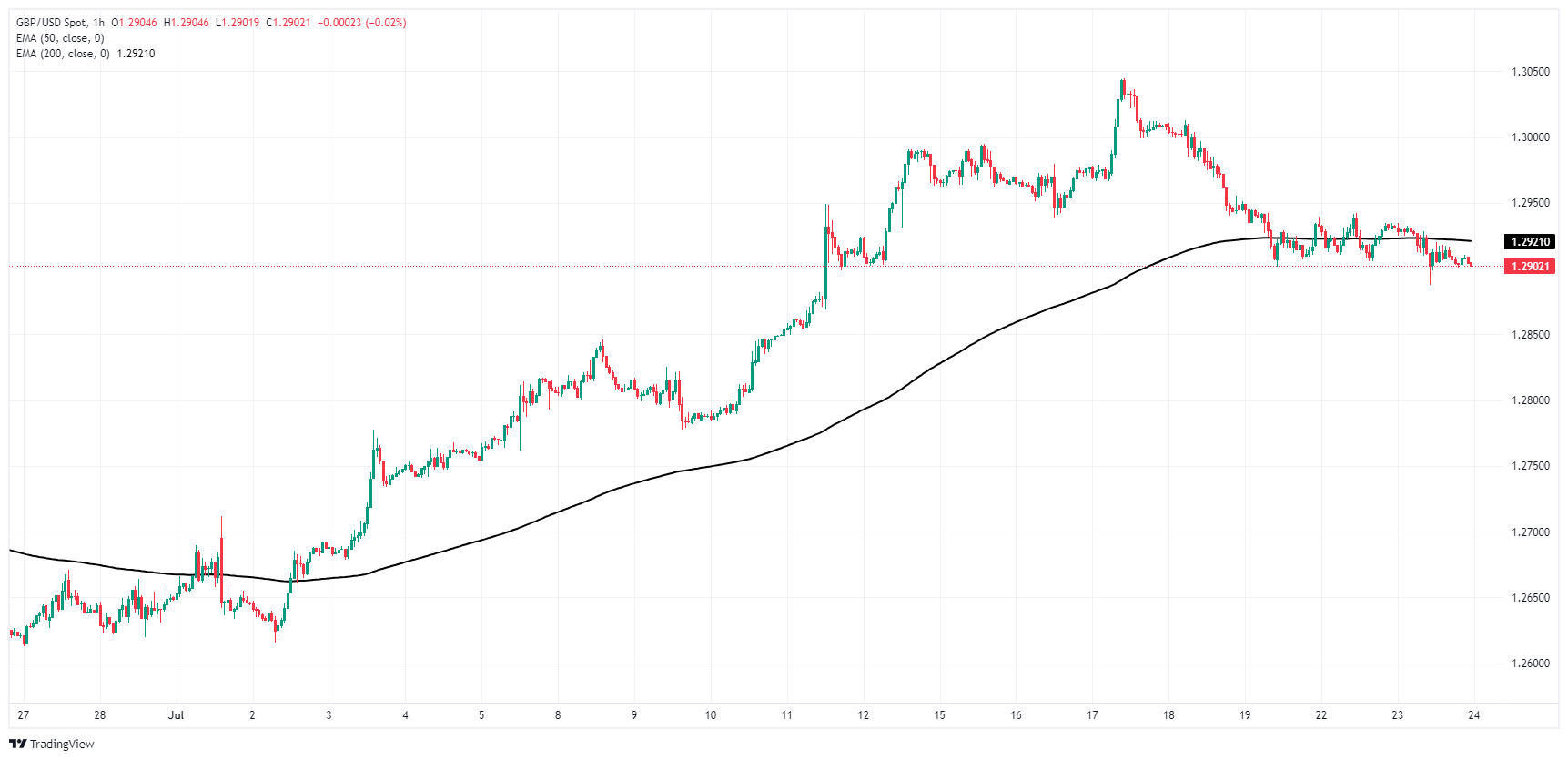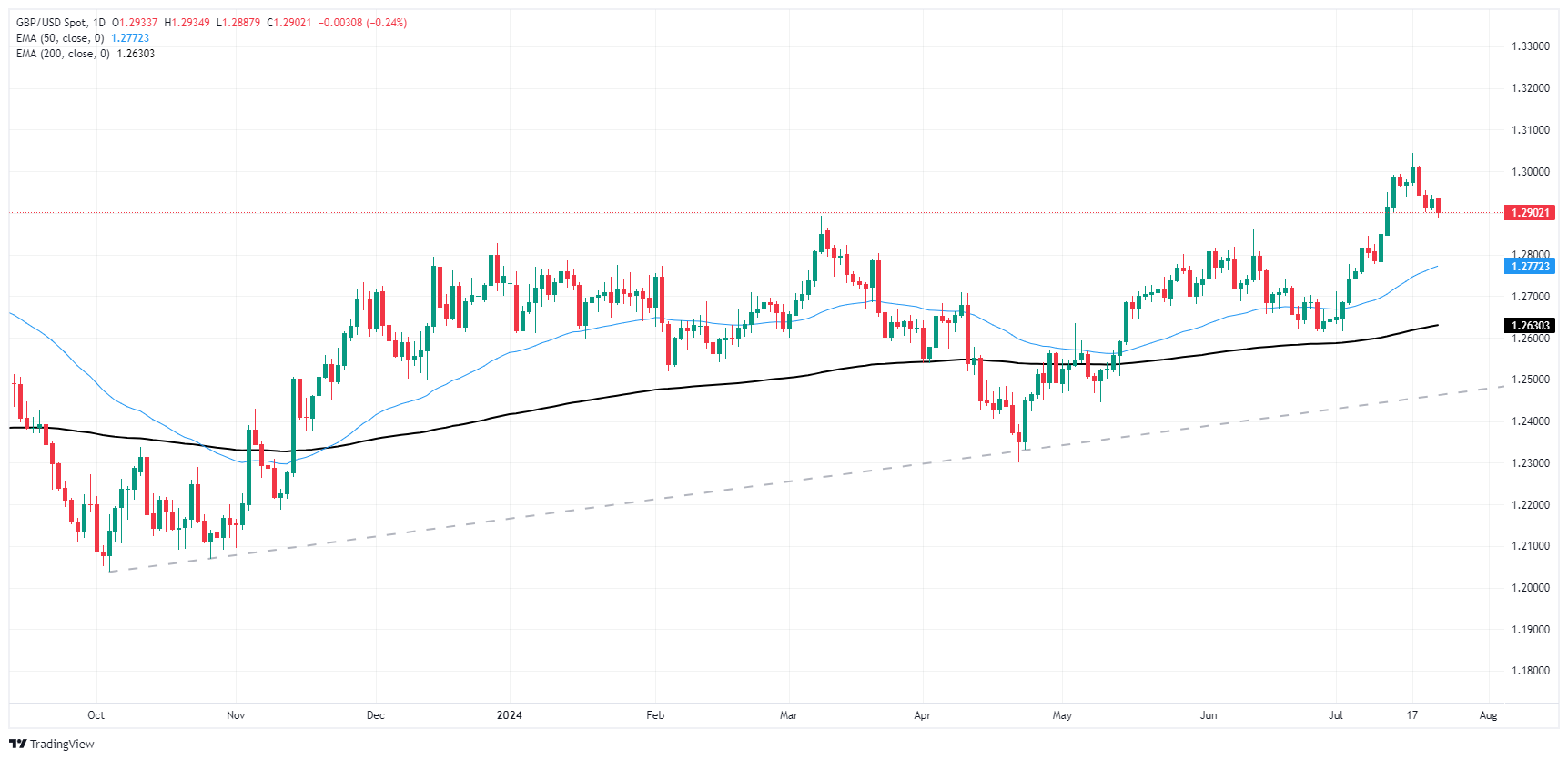- Analytics
- News and Tools
- Market News
- GBP/USD eases back as markets gear up for data-laden midweek
GBP/USD eases back as markets gear up for data-laden midweek
- GBP/USD declined one-fifth of one percent on Tuesday.
- A quiet start to the week ends with Wednesday’s double-header PMI data.
- US GDP due on Thursday, PCE inflation on Friday.
GBP/USD eased lower on Tuesday to decline one-fifth of one percent as traders buckle up for a hectic midweek market session after a quiet start to the trading week. S&P Purchasing Managers Index (PMI) activity figures are due on both sides of the Atlantic, and further key US data is due throughout the back half of the trading week.
Forex Today: Global PMIs take centre stage
UK PMI activity survey results will kick off Wednesday’s London market session, and investors are broadly expecting a recovery in July’s UK Services PMI. The UK’s Services PMI dipped to a seven-month low of 52.1 in June, and median market forecasts expect a rebound to 52.5.
On the US side, July’s Services PMI is expected to ease slightly to 54.4 from June’s 55.3. Global markets are broadly forecasting a September rate cut from the Federal Reserve (Fed), and investors are looking for further signs of softening in US economic figures in order to hammer in the rate outlook. Rate traders are pricing in nearly 100% odds of at least a quarter-point rate cut from the Federal Open Market Committee (FOMC) at the September 18 rate call.
Rolling through the week, quarterly US Gross Domestic Product figures are slated for Thursday, with US Personal Consumption Expenditure Price Index (PCE) inflation on the books for Friday. Annualized Q2 US GDP is forecast to tick up to 1.9% from 1.4%, while Core PCE inflation on Friday is expected to cool further on a YoY basis to 2.5% for the year ended in June compared to the previous month’s 2.6%.
British Pound PRICE This week
The table below shows the percentage change of British Pound (GBP) against listed major currencies this week. British Pound was the strongest against the Australian Dollar.
| USD | EUR | GBP | JPY | CAD | AUD | NZD | CHF | |
|---|---|---|---|---|---|---|---|---|
| USD | 0.29% | 0.09% | -1.03% | 0.49% | 1.08% | 1.03% | 0.42% | |
| EUR | -0.29% | -0.21% | -1.35% | 0.16% | 0.83% | 0.68% | 0.06% | |
| GBP | -0.09% | 0.21% | -1.25% | 0.36% | 1.04% | 0.88% | 0.25% | |
| JPY | 1.03% | 1.35% | 1.25% | 1.57% | 2.20% | 2.04% | 1.40% | |
| CAD | -0.49% | -0.16% | -0.36% | -1.57% | 0.68% | 0.54% | -0.09% | |
| AUD | -1.08% | -0.83% | -1.04% | -2.20% | -0.68% | -0.14% | -0.78% | |
| NZD | -1.03% | -0.68% | -0.88% | -2.04% | -0.54% | 0.14% | -0.58% | |
| CHF | -0.42% | -0.06% | -0.25% | -1.40% | 0.09% | 0.78% | 0.58% |
The heat map shows percentage changes of major currencies against each other. The base currency is picked from the left column, while the quote currency is picked from the top row. For example, if you pick the British Pound from the left column and move along the horizontal line to the US Dollar, the percentage change displayed in the box will represent GBP (base)/USD (quote).
GBP/USD technical outlook
GBP/USD extended a near-term decline from 12-month highs, falling back into the 1.2900 handle. Cable is down -1.2% peak-to-trough from 52-week highs near 1.3045, however the pair remains buried deep in bull country, trading well above the 200-day Exponential Moving Average (EMA) at 1.2629.
An extended decline will see the pair dropping through the 50-day EMA at 1.2772, but bidders will be looking for a quick pivot into fresh 52-week highs above 1.3050.
GBP/USD hourly chart
GBP/USD daily chart
Pound Sterling FAQs
The Pound Sterling (GBP) is the oldest currency in the world (886 AD) and the official currency of the United Kingdom. It is the fourth most traded unit for foreign exchange (FX) in the world, accounting for 12% of all transactions, averaging $630 billion a day, according to 2022 data. Its key trading pairs are GBP/USD, aka ‘Cable’, which accounts for 11% of FX, GBP/JPY, or the ‘Dragon’ as it is known by traders (3%), and EUR/GBP (2%). The Pound Sterling is issued by the Bank of England (BoE).
The single most important factor influencing the value of the Pound Sterling is monetary policy decided by the Bank of England. The BoE bases its decisions on whether it has achieved its primary goal of “price stability” – a steady inflation rate of around 2%. Its primary tool for achieving this is the adjustment of interest rates. When inflation is too high, the BoE will try to rein it in by raising interest rates, making it more expensive for people and businesses to access credit. This is generally positive for GBP, as higher interest rates make the UK a more attractive place for global investors to park their money. When inflation falls too low it is a sign economic growth is slowing. In this scenario, the BoE will consider lowering interest rates to cheapen credit so businesses will borrow more to invest in growth-generating projects.
Data releases gauge the health of the economy and can impact the value of the Pound Sterling. Indicators such as GDP, Manufacturing and Services PMIs, and employment can all influence the direction of the GBP. A strong economy is good for Sterling. Not only does it attract more foreign investment but it may encourage the BoE to put up interest rates, which will directly strengthen GBP. Otherwise, if economic data is weak, the Pound Sterling is likely to fall.
Another significant data release for the Pound Sterling is the Trade Balance. This indicator measures the difference between what a country earns from its exports and what it spends on imports over a given period. If a country produces highly sought-after exports, its currency will benefit purely from the extra demand created from foreign buyers seeking to purchase these goods. Therefore, a positive net Trade Balance strengthens a currency and vice versa for a negative balance.
© 2000-2025. All rights reserved.
This site is managed by Teletrade D.J. LLC 2351 LLC 2022 (Euro House, Richmond Hill Road, Kingstown, VC0100, St. Vincent and the Grenadines).
The information on this website is for informational purposes only and does not constitute any investment advice.
The company does not serve or provide services to customers who are residents of the US, Canada, Iran, The Democratic People's Republic of Korea, Yemen and FATF blacklisted countries.
Making transactions on financial markets with marginal financial instruments opens up wide possibilities and allows investors who are willing to take risks to earn high profits, carrying a potentially high risk of losses at the same time. Therefore you should responsibly approach the issue of choosing the appropriate investment strategy, taking the available resources into account, before starting trading.
Use of the information: full or partial use of materials from this website must always be referenced to TeleTrade as the source of information. Use of the materials on the Internet must be accompanied by a hyperlink to teletrade.org. Automatic import of materials and information from this website is prohibited.
Please contact our PR department if you have any questions or need assistance at pr@teletrade.global.















